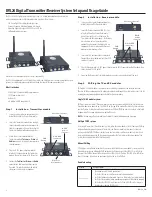
1
DVL24_PQ
Step 2. Installation - Receiver module
1. Screw an antenna onto the connector on the
back of the back of the Receiver module.
2. Locate the Receiver module within 300’ (line
of sight) of the of the Transmitter module. If
obstructions (walls, etc.) exist between the
Transmitter and Receiver modules, the Receiver
must be closer to the Transmitter, or the
optional hi-gain antenna should be used. Use
appropriate fasteners to anchor the Receiver
module to the mounting surface
3. Two sets of A/V out connectors are provided.
Connect them to a monitor and/or VCR or DVR
recorder, as needed.
DC12V
power
connector
A/V out RCA
connectors
PAIR
button
Antenna connector
4. Plug the Receiver module 12 VDC power adapter into the DC12V connector on the RX module, then
into a standard 120 VAC outlet.
5. Power on the Receiver and Transmitter modules using the switch on the back of the units.
Step 3. PAIRing the TX and RX modules
PAIRing the TX and RX modules is the process for establishing a communication link between them.
Effective PAIRing is achieved when the video and audio carried through the system can be seen at the A/V
recording or monitoring equipment connected to the Receiver module.
Single TX / RX module system
PAIRing a single Transmitter / Receiver module system occurs automatically when the Transmitter and
Receiver modules are powered on. The LINK LED on the top of the modules flash initially, then remain on
constantly when Transmitter and Receiver modules are PAIRed. If PAIRing is lost, it can be re-established
by powering off, then powering on one or both of the units.
NOTE
: After powering off either module, wait about 10 seconds before powering it on again.
Multiple TX/RX systems
In a multiple Transmitter / Receiver module system, place Receiver modules at least 1 foot apart. PAIRing
can be performed by powering on each Transmitter and Receiver module system one at a time and
waiting until they PAIR. If PAIRing is lost between one Transmitter and Receiver module system, it can
be re-established by powering off, then powering on either the Transmitter or Receiver module of the
system, then allowing them to PAIR automatically.
Manual PAIRing
If PAIRing was not achieved automatically (no video signal from the receiver module), it can be manually
initiated by pressing and holding the PAIR button on the Transmitter until the LINK LED starts flashing,
then press the PAIR button on the Receiver until the LINK LED starts flashing. The LINK LED will flash for
about 10 seconds, then remain on continuously when the units are PAIRed.
Troubleshooting
Problem
Possible Solutions
No video or audio
•
Check power and A/V cable connections.
•
Verify that the camera and Receiver module are powered on.
•
Verify that video and audio source signals are fed into the Transmitter module
•
Verify that the recording/video monitoring equipment is functioning properly.
•
Verify that the LINK LEDs are lit constantly. If the LINK LEDs are flashing, use
the procedure above to PAIR the units.
The DVL24 2.4GHz Digital transmitter/receiver system is a reliable and exceptionally easy to install
wireless communications link for video and audio. It includes these features:
•
300’ line of sight (transmitter to receiver) range
•
Dynamic frequency allocation to avoid interference
•
Operating frequency range 2.4000 GHZ to 2.4835 GHz
•
3 dB omnidirectional antenna
A local area can accommodate up to 4 systems concurrently.
The DVL24 is composed of a 2.4 GHz digital transmitter and a digital wireless receiver. An optional hi-gain
antenna is available to improve reception and extend the range of the communications link.
What’s in the box
•
DVL24 Digital Transmitter and Receiver modules
•
12 VDC power adapter (2)
•
Antenna (2)
•
A/V cable with RCA connectors (2)
Step 1. Installation - Transmitter module
1. Screw an antenna onto the connector on the
back of the back of the Transmitter module.
2. Locate the Transmitter module close enough
to your video and audio sources to connect to
them. Use appropriate fasteners to anchor the
Transmitter module to the mounting surface.
3. Attach the A/V cable provided to the
Transmitter module
To Camera - Video
and
Audio
connectors, then plug it into your video
and audio sources.
4. Plug the 12 VDC power adapter provided
into the DC12V connector on the Transmitter
module, then into a standard 120 VAC outlet.
5. Connect the
To Monitor - Video
and
Audio
connector to a local monitor and/or speaker
if needed. This interface can be used to help
setup your camera and/or microphone.
DC12V
power
connector
A/V in RCA
connectors
A/V out to
local monitors
PAIR
button
Antenna connector
DVL24 Digital Transmitter/Receiver System Setup and Usage Guide




















